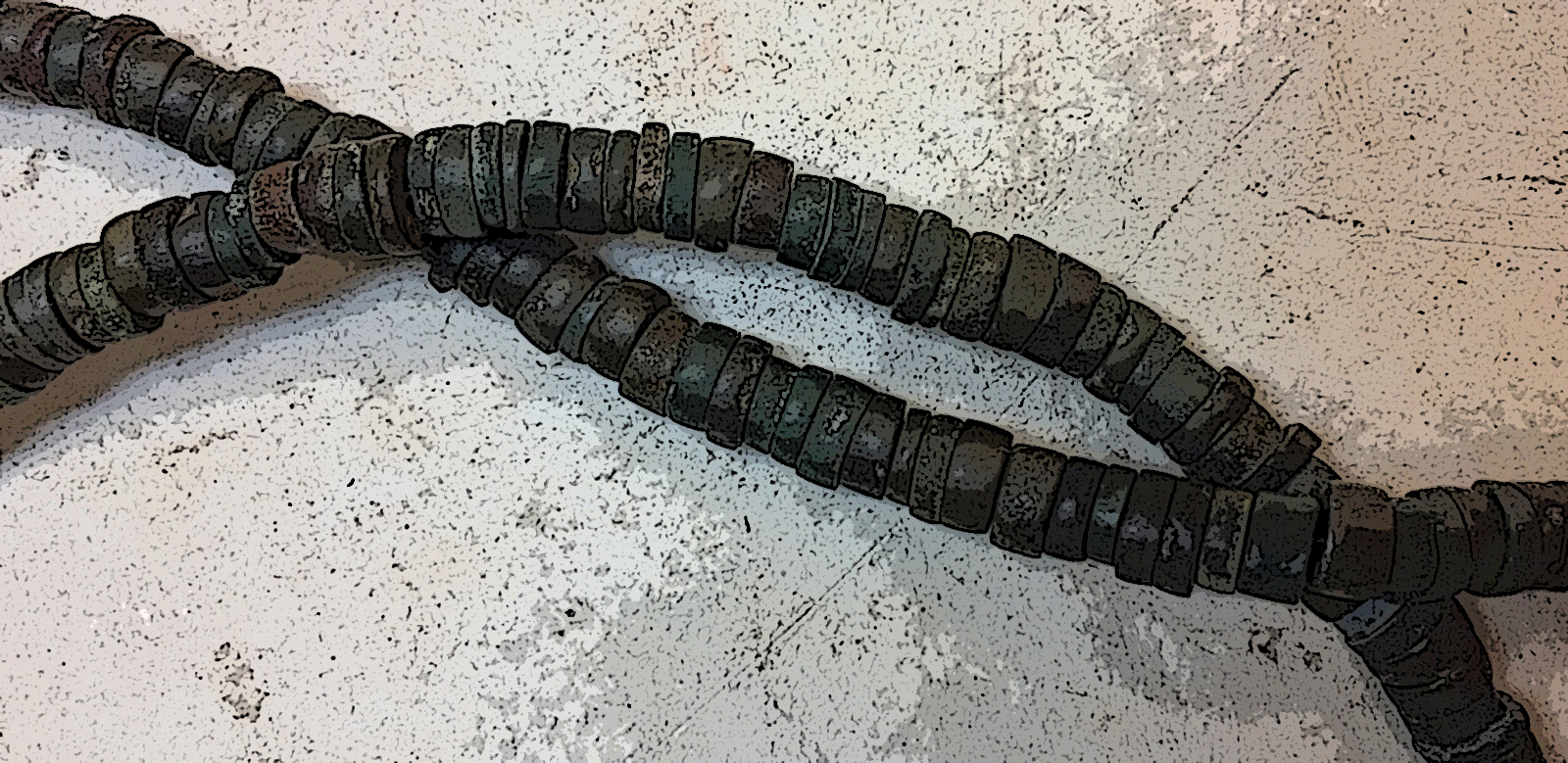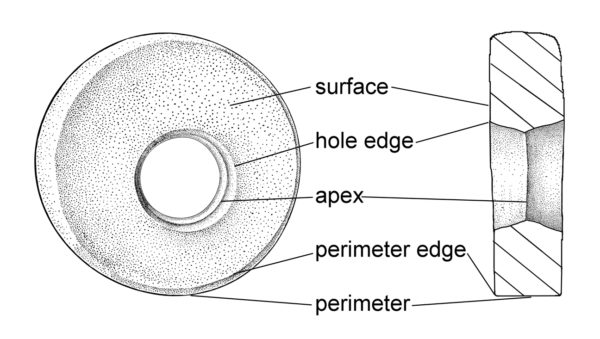
Archaeological Conundrum: The Tiny Disk Bead
Desert Archaeology’s ground stone expert, Jenny Adams, explores a different sort of artifact this week–one that poses vexing problems, raises interesting questions, and may or may not even be made of stone.
How can something be whole and part of a whole at the same time? The tiny disk bead exemplifies this seeming paradox. Each one was made individually as a separate entity, but was added to other individual beads and ornaments to become a whole—a necklace, a bracelet, or an earring.
In the Tucson Basin and elsewhere in the U.S. Southwest, disk beads were made from stone, shell, and fired clay. They were also amazingly small, averaging roughly 5 mm in diameter (about the size of a small lentil). Dr. Emil Haury noted the difficulty involved in differentiating stone from clay specimens in a journal article more than 80 years ago. I encountered the same problem when analyzing (and counting) thousands of tiny disk beads found during Desert Archaeology’s excavations at the Cienega phase Wetlands site in the eastern Santa Cruz River floodplain, the Hohokam Yuma Wash site on the west side of the river, and the Hohokam Honey Bee Village site in Oro Valley—collectively more than 13,000 disk beads. Here are some tips for telling apart stone and fired-clay beads.

Photomicrograph of a stone (turquoise) disk bead from the pre-Classic Hohokam La Villa site in Phoenix, magnified 20x (actual diameter 4 mm). The irregularity in the hole is from being drilled partway through on each side. This is a rare example of a bead that is from a non-mortuary context, and thus may be photographed. Photograph by Jenny Adams.
Fired-clay beads were made by rolling a thin layer of clay around a twig or plant stem. While still soft, the clay tube was incised to form a row of attached bead blanks. After the incised tube was fired to harden the clay and burn away the stem, the beads were snapped apart along the incised grooves, leaving a rough edge around an off-center, irregularly round hole. When beads were snapped off the tube along the incision, a lip was left around the hole on one side, and a corresponding concavity around the hole on the facing surface of the next bead in line. Sometimes these distinctive attributes were ground away by rubbing the bead against an abrasive stone, making them even more difficult to tell apart from stone beads without viewing them at least at 20x magnification. Fired-clay beads also have a distinctive texture when viewed under the microscope at 20-40x magnification, as rolling the clay around the stem to form the hole created a circular “flow” to the clay.

Drawing depicting how a clay tube could be incised for snapping apart into fired-clay beads, along with the distinctive features of the finished beads. Like the photographed turquoise bead above, these are tiny artifacts with diameters of roughly 5 mm. Illustration by Robert Ciaccio.
In contrast, most stone beads were formed by grinding and drilling individual pieces of stone into tiny disks. If the hole drilled with a flaked stone drill bit is conical (one opening narrower than the other), we know that the hole was drilled from one side. If the hole is biconical (wide openings on both sides, narrowing in the center of the bead), it was drilled from both sides. The use of a cactus needle as a drill bit leaves a more cylindrical hole. Abrasive sand and lubricating water would have helped drill the hole, but no matter which drilling method was used, abrasions inside the hole are clearly visible unless they have been worn away. Some stone beads were made by drilling through a stone tube that was incised in the same manner as the clay tubes, resulting in the same lip and concavity around the holes when the beads were snapped off the tube. However, the drill bit left a more sharp-shouldered, symmetrical hole than the grass stem used to form clay beads. Thus, the hole is the most obviously distinctive feature between beads of stone and clay.

Line drawing of a stone disk bead from Yuma Wash. Note the more circular hole made by drilling compared to the hole of a clay bead formed around a grass stem. This hole is biconical (wide at the openings, narrow in the center, or apex), indicating that it was drilled from both sides of the bead. Illustration by Robert Ciaccio.
The colors of some fired-clay beads were controlled by firing techniques that reduced the amount of oxygen reaching the beads, resulting in shades of black/gray, or allowed ample oxygen, resulting in shades of red/orange. These colors are amazingly close to the colors of mudstone or argillite, respectively—rock varieties that were commonly used to make stone beads.
Why would it be important to make fired-clay beads look so similar to stone beads?
In an article I’m submitting for journal publication, I argue that using clay to simulate stone beads was for honorific reasons, not for faking wealth. Not everyone was buried with disk beads. Those who were belonged to social groups that signified their affiliation by placing disk beads with their deceased. Some people were buried with complete necklaces, bracelets, or earrings that were strung with disk beads, while others were buried with one or more loose beads; both strategies exemplify in different ways the concept of being both an individual and part of a whole social group. The placement of strung beads with an individual signaled a more complete integration in the social group—perhaps through initiation or something similar—and loose beads a more relational or honorific association. These are some of the thoughts that I am working with right now while reading through ethnographic sources for modeling the use of disk beads in mortuary contexts.


